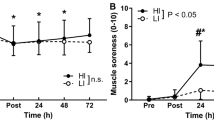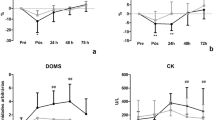Abstract
The purpose of this study was to investigate whether plasma activities of creatine kinase (CK) and glutamic-oxaloacetic transaminase (GOT), elevated by eccentric exercise, would be affected by a second bout of eccentric exercise. A group of 26 male students [20.3 (SD 1.9) years] were placed in one of three groups. Group A (n = 8) performed one bout of 24 maximal eccentric actions (ECC) of the forearm flexors (ECC1), and groups B (n = 10) and C (n = 8) performed two bouts of ECC (ECC1, ECC2). The ECC2 was performed by the opposite arm 3 days (group B) or 5 days (group C) after ECC1. None of the subjects had performed this eccentric exercise prior to this study. Maximal isometric force (MIF), range of motion (ROM), upperarm circumference (CIR), muscle soreness level (SOR), and plasma CK and GOT activities were measured before and for 8 days (group B) or 10 days (groups A, C) postexercise. The MIF, ROM, CIR, and SOR changed significantly after exercise (P<0.01), and no significant differences in changes were found between ECC1 and ECC2, or among the groups. This suggested that ECC1 and ECC2 produced a similar stress to the forearm flexor muscles. Therefore, it was expected that CK and GOT activities would show similar increases after ECC1 and ECC2. However, increases in CK and GOT activities after ECC2 were significantly smaller (P<0.01) than after ECC1 in both groups B and C. The results of this study confirmed that CK and GOT responses were diminished when initial blood enzyme activities were elevated.
Similar content being viewed by others
References
Bijsterbosch MK, Duursma AM, Smit MJ, Bos OJM, Bouma JMW, Gruber M (1985) Several dehydrogenases and kinases compete for endocytosis from plasma by rat tissues. Biochem J 229:409–417
Carlson CJ, Meister W, Emilson B, Sheiner LB, Rapaport E (1992) Clearance of serum creatine kinase activity. Cardiovasc Res 16:66–70
Clarkson PM, Ebbeling C (1988) Investigation of serum creatine kinase variability after muscle-damaging exercise. Clin Sci 75:257–261
Clarkson PM, Nosaka K, Braun B (1992) Muscle function after exercise-induced muscle damage and rapid adaptation. Med Sci Sport Exerc 24:512–520
Evans WJ, Cannon JG (1991) The metabolic effect of exercise-induced muscle damage. Exerc Sport Sci Rev 19:99–127
Hsu H, Watanabe J (1983) The implication of thoracic duct lymph in the distribution and elimination of rabbit muscle creatine phosphokinase. Chem Pharm Bull 31:3269–3276
Husic HD, Suelter C (1983) The levels of creatine kinase and adenylate kinase in the plasma of dystrophic chickens reflect the rates of loss of these enzymes from the circulation. Biochem Med 29:318–336
Kagen LJ, Aram S (1987) Creatine kinase activity inhibitor in sera from patients with muscle disease. Arthritis Rheum 30:213–217
King SW, Statland BE, Savory J (1976) The effect of a short burst of exercise on activity values of enzyme in sera of healthy young men. Clin Chim Acta 72:211–218
Lindena J, Trautschold I (1983) Enzyme in lymph: a review. J Clin Chem Biochem 21:327–346
Manfredi TG, Fielding RA, O'Reilly KP, Meredith CN, Lee HY, Evans WJ (1991) Plasma creatine kinase activity and exercise-induced muscle damage in older men. Med-Sci Sport Exerc 23:1028–1034
Newham DJ, Jones DA, Edwards RHT (1983) Large delayed plasma creatine kinase changes after stepping exercise. Muscle Nerve 6:380–385
Nosaka K, Clarkson PM (1992) Relationship between post-exercise plasma CK elevation and muscle mass involved in the exercise. Int J Sport Med 13:471–475
Nosaka K, Clarkson PM, McGuiggin ME, Byrne JM (1991) Time course of muscle adaptation after high-force eccentric exercise. Eur J Appl Physiol 63:70–76
Smit MJ, Beekhuis H, Duursma AM, Bouma JM, Gruber M (1988) Catabolism of circulating enzymes: plasma clearance, endocytosis, and breakdown of lactate dehydrogenase-1 in rabbits. Clin Chem 34:2475–2480
Van Der Meulen JH, Kuipers H, Drukker J (1991) Relationship between exercise-induced muscle damage and enzyme release in rats. J Appl Physiol 71:999–1004
Author information
Authors and Affiliations
Rights and permissions
About this article
Cite this article
Nosaka, K., Clarkson, P.M. Effect of eccentric exercise on plasma enzyme activities previously elevated by eccentric exercise. Eur J Appl Physiol 69, 492–497 (1994). https://doi.org/10.1007/BF00239865
Accepted:
Issue Date:
DOI: https://doi.org/10.1007/BF00239865




